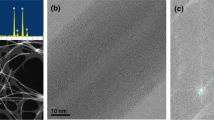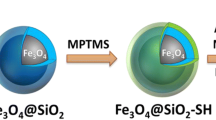Abstract
This contribution reports on the development of two versatile and efficient methods, namely the green and gamma radiolysis for Fe-Ag nanoparticles (NPs) synthesis, characterization, and further their growth inhibition potential on some spoilage microorganisms. Green Ag/Fe2O3 NPs were obtained at Fe-Ag [3:1], annealing temperature of 800 °C for 2 h, and gamma irradiated Ag/Fe3O4 NPs were obtained at Fe-Ag [7:1], a 50 kGy dose. The characterization techniques were performed with these two samples whereby the sizes from crystallographic and microscopic analyses were 39.59 and 20.00 nm for Ag/Fe2O3 NPs, 28.57 and 15.37 nm for Ag/Fe3O4 NPs, respectively. The polycrystallinity nature observed from X-ray diffraction was in accordance with the selected area electron diffraction. The vibrational properties confirmed the presence of bimetallic Fe-Ag NPs with the depiction of chemical bonds, Fe–O and Ag–O from attenuated total reflection-Fourier transform infrared spectroscopy and elements Ag, Fe, O from energy-dispersive X-ray spectroscopy analyses. The magnetic properties carried out using a vibrating sample magnetometer suggested a superparamagnetic behavior for the Ag/Fe2O3 NPs and a ferromagnetic behavior for the Ag/Fe3O4 NPs. Overall, the green Ag/Fe2O3 NPs successfully inhibited the growth of spoilage yeasts Candida guilliermondii, Zygosaccharomyces fermentati, Zygosaccharomyces florentinus, and spoilage molds Botrytis cinerea, Penicillium expansum, Alternaria alstroemeriae.






Similar content being viewed by others
References
C.A. Monteiro, R.B. Levy, R.M. Claro, I.R. Castro, G. Cannon, A new classification of foods based on the extent and purpose of their processing. Cad Saude Publica 26(11), 2039–2049 (2010). https://doi.org/10.1590/s0102-311x2010001100005
J.M. Zuehlke, B. Petrova, C.G. Edwards, Advances in the control of wine spoilage by Zygosaccharomyces and Dekkera/Brettamoyces. Annu. Rev. Food Sci. Technol. 4, 57–58 (2013)
M. Mewa-Ngongang, H.W. du Plessis, U.F. Hutchinson, L. Mekuto, S.K.O. Ntwampe, Kinetic modelling and optimization of antimicrobial compound production by Candida pyralidae KU736785 for control of Candida guilliermondii. Food Sci. Technol. Inter. 23(4), 1–13 (2017)
M. Mewa-Ngongang, H.W. du Plessis, E. Hlangwani, S.K.O. Ntwampe, B.S. Chidi, U.F. Hutchinson, P.N. Neil, Activity interactions of crude biopreservatives against spoilage yeast consortia. Fermentation 5(3), 53 (2019). https://doi.org/10.3390/fermentation5030053
S. Droby, V. Vinokur, B. Weiss, L. Cohen, A. Daus, E.E. Goldschmidt, R. Porat, Induction of resistance to Penicilium digitatum in grapefruit by the yeast biocontrol agent Candida oleophila. Phytopathology 92, 393–399 (2002)
F. Comitini, N.D. Pietro, L. Zacchi, I. Mannazzu, M. Ciani, Kluyveromyces phaffii killer toxin active against wine spoilage yeasts: purification and characterization. Microbiology 150(8), 2535–2541 (2004)
N.N. Mehlomakulu, M.E. Setati, B. Divol, Characterization of novel killer toxins secreted by wine-related non-Saccharomyces yeasts and their action on Brettanomyces spp. Inter. J. Food Microbiol. 188, 83–91 (2014)
C.J. Moir, 2001 Spoilage of processed foods: Causes and diagnosis. The Food Microbiology Group of the Australian Institute of Food Science and Technology Inc., Waterloo, NSW
R.R. Sharma, D. Singh, R. Singh, Biological control of postharvest diseases of fruits and vegetables by microbial antagonists: a review. Biol. Control 50(3), 205–221 (2009)
J.I. Pitt, A.D. Hocking, Fungi and food spoilage, 3rd edn. (Springer, Boston, 2009), pp.357–382
B. Williamson, B. Tudzynski, P. Tudzynski, J.A.V. Kan, Botrytis cinerea: the cause of grey mould disease. Mol. Plant Pathol. 8(5), 561–580 (2007)
M.D. Kirk, S.M. Pires, R.E. Black, M. Caipo, J.A. Crump, B. Devleesschauwer, D. Döpfer, A. Fazil, C.L. Fischer-Walker, T. Hald, A.J. Hall, K.H. Keddy, R.J. Lake, C.F. Lanata, P.R. Torgerson, A.H. Havelaar, F.J. Angulo, World health organization estimates of the global and regional disease burden of 22 foodborne bacterial, protozoal, and viral diseases, 2010: a data synthesis. PLoS Med. 12(12), e1001921 (2015). https://doi.org/10.1371/journal.pmed.1001921
R.K. Yadav, R. Gupta, Impact of chemical food preservatives through local product on human health a review. High Technol. Lett. 27(6), 767–773 (2021). https://doi.org/10.37896/HTL27.6/3780
G. Sharma, N.D. Jasuja, M. Kumar, M.I. Ali, Biological synthesis of silver nanoparticles by cell-free extract of spirulina platensis. J. Nanotechnol. 2015(4), 1–6 (2015). https://doi.org/10.1155/2015/132675
L.Y. Wang, J. Luo, S.Y. Shan, E. Crew, J. Yin, C.J. Zhong, B. Wallek, S.S.S. Wong, Bacterial inactivation using silver-coated magnetic nanoparticles as functional antimicrobial agents. Anal. Chem. 83, 8688–8695 (2011)
Y. Li, W. Zhang, J. Niu, Y. Chen, Mechanism of photogenerated reactive oxygen species and correlation with the antibacterial properties of engineered metal-oxide nanoparticles. ACS Nano 6(6), 5164–5173 (2012). https://doi.org/10.1021/nn300934k
D. Zahra, R. Mojtaba, G. Mostafa, K. Fatemeh, Green synthesis of Ag-Fe3O4 nanocomposite utilizing Eryngium planum L. leaf extract and its potential applications in medicine. J. Drug Deliv. Sci. Technol. 67, 102941 (2022). https://doi.org/10.1016/j.jddst.2021.102941
T. Zargar, A. Kermanpur, Effects of hydrothermal process parameters on the physical, magnetic, and thermal properties of Zn0.3 Fe2.7O4 nanoparticles for magnetic hyperthermia applications. Ceram. Int. 43(7), 5794–5804 (2017)
S. Arokiyaraj, M. Saravanan, N.K.U. Prakash, A.M. Valan, B. Vijayakumar, S. Vincent, Enhanced antibacterial activity of iron oxide magnetic nanoparticles treated with Argemonemexicana L. leaf extract: an in vitro study. Mater. Res. Bull. 48(9), 3323–3327 (2013)
B. Liu, J. Zhou, B. Zhang, J. Qu, Synthesis of Ag@Fe3O4 nanoparticles for photothermal treatment of ovarian cancer. J. Nanomater. 2019, 6457968 (2019). https://doi.org/10.1155/2019/6457968
A. Mohamed, R.B. Parvatheeswara, M.O. Abdel-Hamed, K. CheolGi, Modified polyol route for synthesis of Fe3O4/Ag and α-Fe/Ag nanocomposite. J. Alloys Compd. 615, 308–312 (2014)
P. Lu, T. Jing, C.Y. Hong, Synthesis of Fe3O4, Fe2O3, Ag/Fe3O4 and Ag/Fe2O3 nanoparticles and their electrocatalytic properties. Sci. China Chem. 56(3), 362–369 (2013). https://doi.org/10.1007/s11426-012-4763-y
N. Medina-Córdova, R. López-Aguilar, A.I. Campa-Córdova, C. Angulo, Biocontrol activity of the marine yeast debaryomyces hanseni against phytopathogenic fungi and its ability to inhibit mycotoxins production in maize grain (Zea mays L.). Biol. Control. 97, 70–79 (2016)
D.K. Chmielewska, U. Gryczka, W. Migdal, Recent patents on creative ionizing radiation in nanotechnology. Recent Pat. Nanotechnol. 2(3), 201–207 (2008). https://doi.org/10.2174/187221008786369615
S. Ying, Z. Guan, P.C. Ofoegbu, P. Clubb, C. Rico, F. He, J. Hong, Green synthesis of nanoparticles: current developments and limitations. Environ. Technol. & Innov. 26, 102336 (2022). https://doi.org/10.1016/j.eti.2022.102336
J.F. Hund, M.F. Bertino, G. Zhang, C.S. Levantis, N. Lewantis, A.T. Tokuhiro, J. Farmer, Formation and entrapment of noble metal clusters in silica monoliths by gamma radiolysis. J. Phys. Chem. B 107, 465–469 (2003)
S. Kalunge, A.V. Humbe, M.V. Khedkar, S.D. More, A.P. Keche, A.A. Pandit, Investigation on synthesis, structural and electrical properties of zinc ferrite on gamma irradiation. J. Phys. Conf. series 1644(1), 012017 (2020). https://doi.org/10.1088/1742-6596/1644/1/012017
V. Makarov, A. Love, O. Sinitsyna, S. Makarova, I. Yaminsky, M. Taliansky, N. Kalinina, Green nanotechnologies: synthesis of metal nanoparticles using plants. Acta Naturae 6(1), 35–44 (2014)
N.G. Shimpi, M. Khan, S. Shirole, S. Sonawane, Process optimization for the synthesis of silver (AgNPs), iron oxide (α-Fe2O3 NPs) and core-shell (Ag-Fe2O3 NPs) nanoparticles using the aqueous extract of alstonia scholaris: a greener approach. The Open Mater. Sci. J. 12(1), 29–39 (2018). https://doi.org/10.2174/1874088X01812010029
L. Wei-Hong, N. Yang, Green and facile synthesis of Ag-Fe3O4 nanocomposites using the aqueous extract of Crataegus pinnatifida leaves and their antibacterial performance. Mater. Lett. 162, 157–160 (2016). https://doi.org/10.1016/j.matlet.2015.09.064
R. Sandupatla, A. Dongamanti, R. Koyyati, Antimicrobial and antioxidant activities of phytosynthesized Ag, Fe and bimetallic Fe-Ag nanoparticles using Passiflora edulis: A comparative study. Mater. Today: Proceed. 44(1), 2665–2673 (2021)
M. Sajjadi, M. Nasrollahzadeh, S.M. Sajadi, Green synthesis of Ag/Fe3O4 nanocomposite using Euphorbia peplus Linn leaf extract and evaluation of its catalytic activity. J. Coll. Interface Sci. 497, 1–13 (2017)
H. Muthukumar, S.K. Palanirajan, M.K. Shanmugam, S.N. Gummadi, Plant extract mediated synthesis enhanced the functional properties of silver ferrite nanoparticles over chemical mediated synthesis. Biotechnology 26, e00469 (2020)
K. Sameer, M. Jadhav, P. Raikar, D.A. Barretto, S.K. Vootlac, U.S. Raikar, Green synthesized multifunctional Ag@Fe2O3 nanocomposites for effective antibacterial, antifungal, and anticancer properties. New J. Chem. 41, 9513–9520 (2017)
S.R. Batakurki, V. Adimule, M.M. Pai, E. Ahmed, P. Kendrekar, Synthesis of Cs-Ag/Fe2O3 Nanoparticles Using Vitis labrusa Rachis Extract as Green Hybrid Nanocatalyst for the Reduction of Arylnitro Compounds. Topics in Catal. (2022). https://doi.org/10.1007/s11244-022-01593-7
J.R. de Oliveira, S.E.A. Camargo, L.D. de Oliveira, Rosmarinus officinalis L. (rosemary) as therapeutic and prophylactic agent. J. Biomed. Sci. 26, 5 (2019). https://doi.org/10.1186/s12929-019-0499-8
S.K. Noukelag, C.J. Arendse, M. Maaza, Biosynthesis of hematite phase Fe2O3 nanoparticles using an aqueous extract of Rosmarinus officinalis leaves. Mater. Today: Proceed. 43, 3679–3683 (2021)
M. Ghaedi, M. Yousefinejad, M. Safarpoor, H.Z. Khafri, M.K. Purkait, Rosmarinus officinalis leaf extract mediated green synthesis of silver nanoparticles and investigation of its antimicrobial properties. J. Ind. Eng. Chem. 31, 167–172 (2015)
M. Mewa-Ngongang, H.W. du Plessis, S.K.O. Ntwampe, B.S. Chidi, U.F. Hutchinson, L. Mekuto, P.J. Neil, Grape Pomace Extracts as Fermentation Medium for the Production of Potential Biopreservation Compounds. Foods 8(2), 51 (2019). https://doi.org/10.3390/foods8020051
M. Hoffmann, V.N. Antonov, L.V. Bekenov, K. Kokko, W. Hergert, A. Ernst, Variation of magnetic properties of Sr2FeMoO6 due to oxygen vacancies. J. Phys. Condens. Matter. 30(30), 305801 (2018). https://doi.org/10.1088/1361-648X/aacb8d
A. Akbarzadeh, M. Samiei, S. Davaran, Magnetic nanoparticles: preparation, physical properties, and applications in biomedicine. Nanoscale Res. Lett. 7(1), 144 (2012). https://doi.org/10.1186/1556-276X-7-144
R.M. Khafagy, Synthesis, characterization, magnetic and electrical properties of the novel conductive and magnetic polyaniline/MgFe2O4 nanocomposite having the core–shell structure. J. Alloys Compd. 509(41), 9849–9857 (2011)
Q. Song, Z.J. Zhang, Shape control and associated magnetic properties of spinel cobalt ferrite nanocrystals. J. Amer. Chem. Soc. 126(19), 6164–6168 (2004)
A.A. Mostafa, A.A. Al-Askar, K.S. Almaary, T.M. Dawoud, E.N. Sholkamy, M.M. Bakri, Antimicrobial activity of some plant extracts against bacterial strains causing food poisoning diseases. Saudi J. Biol. Sci. 25, 361–366 (2018)
S. Moreno, T. Scheyer, C.S. Romano, A.A. Vojnov, Antioxidant and antimicrobial activities of rosemary extracts linked to their polyphenol composition. Free Radical Res. 40(2), 223–231 (2006)
E. Lorenzetti, J.R. Stangarlin, O.J. Kuhn, Antifungal activity of rosemary extract on Macrophomina phaseolina and charcoal rot control in soybean. J. Plant Pathol. 99(3), 783–786 (2017)
Acknowledgements
This research program was generously supported by grants from the National Research Foundation of South Africa (NRF), and the Academy of Sciences for the Developing World (TWAS). The authors acknowledge UNESCO-UNISA Africa Chair in Nanosciences & Nanotechnology, iThemba LABS, the Cape Peninsula University of Technology (CPUT), as well as the University of the Western Cape (UWC) to whom they are all grateful.
Funding
National Research Foundation South Africa, UID:139198; North-West University, RK 16; University of the Western Cape, South Africa.
Author information
Authors and Affiliations
Contributions
Conceptualization, writing- Original draft preparation: Sandrine Kamdoum Noukelag; Data curation, methodology: Sandrine Kamdoum Noukelag, Maxwell Mewa-Ngongang, Siphelo Ngqoloda, Lebogang Kotsedi; Visualization, investigation: Lovasoa Christine Razanamahandry, Malik Maaza; Writing-review and editing: Sandrine Kamdoum Noukelag, Maxwell Mewa-Ngongang, Seteno K.O. Ntwampe, Christopher J. Arendse; Supervision: Malik Maaza.
Corresponding author
Ethics declarations
Conflict of interest
The authors declare no conflict of interest.
Additional information
Publisher's Note
Springer Nature remains neutral with regard to jurisdictional claims in published maps and institutional affiliations.
Rights and permissions
Springer Nature or its licensor holds exclusive rights to this article under a publishing agreement with the author(s) or other rightsholder(s); author self-archiving of the accepted manuscript version of this article is solely governed by the terms of such publishing agreement and applicable law.
About this article
Cite this article
Noukelag, S.K., Mewa-Ngongang, M., Ngqoloda, S. et al. Influence of Synthesis Method on Structural, Morphological, Magnetic, and Antimicrobial Properties of Fe-Ag Nanoparticles. J Inorg Organomet Polym 33, 159–169 (2023). https://doi.org/10.1007/s10904-022-02493-9
Received:
Accepted:
Published:
Issue Date:
DOI: https://doi.org/10.1007/s10904-022-02493-9




